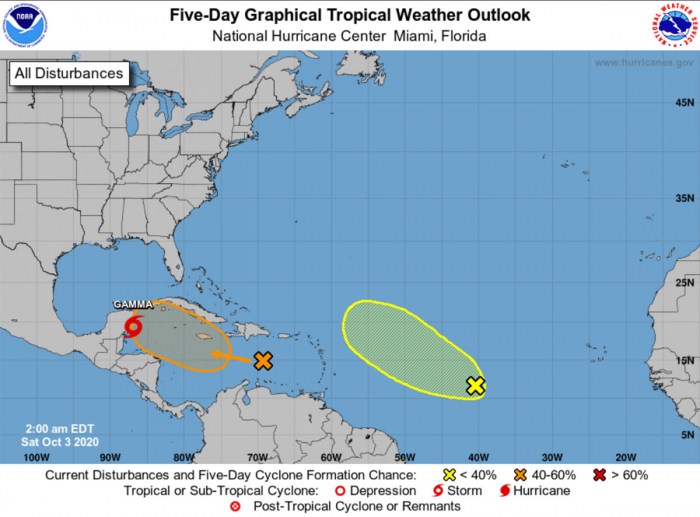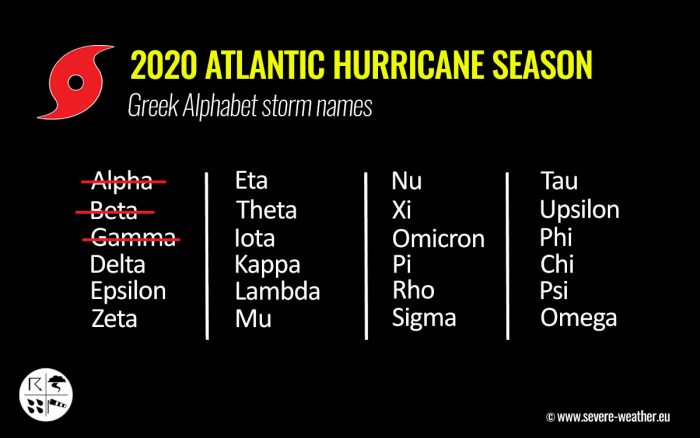A Tropical Storm Gamma formed in the northwestern Caribbean Sea last night. An organizing system is located near the Yukatan peninsula and could bring life-threatening flooding threat over Mexico and the Gulf. Another tropical wave is ongoing in the eastern Caribbean, with the third wave developing east of the Lesser Antilles.
Atlantic hurricane season ramps up again, on its way to set the new record for most named storms
*** NEW UPDATE ***
Key Points
The tropical activity over the Atlantic and the Caribbean region is beginning to increase this weekend again. There are currently three tropical disturbances ongoing; A Tropical Storm Gamma and another wave in the Caribbean, while a newly born depression is over the Central Atlantic.
The main focus goes to the increasing activity with the Tropical Storm Gamma near the Yukatan peninsula, which has been upgraded from a tropical depression last night. Gamma has sustained winds of around 40 knots, and the minimum central pressure around 995 mbar.
The Tropical Storm threat will result in a life-threatening flash flooding over portions of the Yucatan Peninsula, far western Cuba, and well away from the center in the Mexican states of Campeche, Tabasco, and northern Chiapas.
A Tropical Storm Warning is in effect for the Yukatan peninsula.
Both the environmental and oceanic conditions are again becoming more favorable for additional tropical activity over the next two weeks. The Madden-Julian Oscillation (MJO) wave is now emerging in the region from the west, while a very warm Caribbean Sea remains.
Below is the Geocolor NASA satellite image on Saturday morning, revealing a developing Tropical Storm Gamma and the ongoing major Category 4 hurricane Marie in the Eastern Pacific.
Storm Gamma ongoing near the Yucatan peninsula, initially designated as #25L by NHC, has great potential to maintain a tropical-storm-force strength over the next few days. The satellite imagery indicates an increasing explosive convective activity.
NOAA Hurricane Hunters are investigating the system and found tropical storm conditions, one of the reasons the system has been upgraded to Tropical Storm Gamma overnight.
The main impact with Gamma will be torrential and excessive rains over portions of southeastern Mexico, Central America, and western Cuba. Weather model guidance suggests that a Tropical Storm could then continue northwestward across the Gulf towards the US landfall sometime next week.
Developing conditions for the Caribbean
The conditions for developing depression prior to Gamma were very favorable. The sea surface temperatures of the northwestern Caribbean Sea are near 30-31 degrees Celsius (87 degrees F). Low wind shear is present with a very moist atmosphere with a mid-level relative humidity of 80%.
Given such hots seas in the Caribbean region, the necessary ingredient – the fuel for the deep convective storms is there. The attached Ocean Heat Content (OHC) chart indicates OHC is near 150 in the west-central Caribbean. That is quite extreme!
Healthy oceanic conditions are also over the south-southwestern Gulf of Mexico, around Cuba and the Bahamas.
Visible satellite images show that cloudiness and deep convective storms associated with Gamma over the northwestern Caribbean Sea have become significantly better organized since yesterday, with convective banding features becoming prominent.
This system is expected to produce torrential and excessive rainfall, with the potential for flash flooding over portions of southeastern Mexico, Central America, and western Cuba during the next several days.
Tropical Storm Gamma is the 24th storm of the 2020 hurricane season and the third (3rd) named storm from the Greek alphabet list. Gamma is the earliest forming 24th Atlantic named storm on record, breaking the old record set on October 27th, 2005.
Additional disturbances in the Caribbean and Central Atlantic
A tropical wave over the eastern Caribbean Sea is producing a large area of disorganized showers and thunderstorms, accompanied by locally heavy rainfall and gusty winds.
This wave is forecast to move westward at 15 to 20 mph during the next several days, and environmental conditions could become a little more conducive for development when the system is over the central or western Caribbean Sea early next week.
An increasing potential is there as the wave is entering very warm sea waters further west.
The National Hurricane Center (NHC) gives this wave a 40 percent (%) chance to become a tropical depression/storm through the next 5 days. The system surely needs to be monitored for further development and potential threats.
Central Atlantic tropical wave
The third wave, located over the Central Atlantic, indicates that shower activity has increased since yesterday. The activity is in association with a tropical wave located about midway between the coast of Africa and the Lesser Antilles.
Some slow development of this system may occur during the next several days as it moves generally westward to west-northwestward.
The National Hurricane Center (NHC) gives this wave a 10 percent (%) chance to become a tropical depression/storm through the next 5 days.
The next, 4th Greek alphabet letter for the future storm names is Delta.
The only other time the Greek alphabet was used was the 2005 season. There were 28 named storms in that year, including 6 storms from the Greek alphabet list. The last-named storm that season was Tropical Storm Zeta.
Satellite analysis
There is quite a large cyclonic circulation existing over Central America and the Caribbean. The most active storms indicate very deep and well-defined convection near the Tropical Storm Gamma. Storms are already affecting the Yukatan peninsula.
The infrared satellite imagery indicates that convective bands include explosive storms with clouds top temperature near -85 °C.
While the water vapor satellite scan does reveal a broader picture. There is quite a lot of mid-level moisture present across the whole circulation, the outflow ventilation is quite impressive.
The depression seems to be ready for maintaining a tropical-storm-force strength or even some further strengthening while crossing northern Yukatan this weekend.
Gamma will move into the southwestern portions of the Gulf of Mexico early next week.
Forecast track for Gamma
The future track of Tropical Storm Gamma suggests that the upper-level ridge to the north of it should keep it moving westward-northwestward over the weekend.
Gamma will track to the coast of the Yucatan Peninsula (Mexico) on Saturday, although there is also a possibility that the center missed Yucatan and remains over water. The pattern could steer it north through the Yucatan Channel between Cuba and Mexico.
However, a lot of uncertainties remain how the track of Storm Gamma will be early next week. Gamma is a part of a broad cyclonic circulation over Central America, also the other tropical wave over the eastern Caribbean may play an important role in the system’s track.
Video animation of a developing system today and over the weekend. A broad circulation is well visible. Graphics by Tropical Tidbits.
Besides the possible interaction with the Yukatan peninsula, another feature that could interfere with the future development of Tropical Storm Gamma. There is a broad channel of dry air over the Gulf of Mexico, left in the wake of the frontal system several days ago. Mid-range models do indicate these potential limiting factors for the Gamma.
Surely conditions are further evolution needs to be monitored closely. As if the system does battle those strongly, there will be an increased potential for the Gulf Coast tropical threat next week.
Extreme rains and flooding threat develop
The main threat with Tropical Storm Gamma will be torrential and excessive rains over portions of southeastern Mexico, Central America, and western Cuba. A slow-moving nature of the system will lead to extreme amounts of rain in some areas, probably several hundred liters per sq meter (15-20 inches) will be possible.
The above graphics are provided by Windy.
What’s next for the Atlantic basin?
Based on the Department of Atmospheric Science forecasters from the Colorado State University (CSU), “the next two weeks will be characterized by above-normal tropical cyclone activity“.
“The Madden-Julian Oscillation (MJO) is currently located in phase 5 over the Maritime Continent and is forecast to effectively stall over the next two weeks, likely due to the background base state driven by La Niña conditions“, forecasters noted.
The above graphics are provided by NOAA.
“The forecast large-scale circulation is generally favorable for Atlantic hurricane activity, with enhanced vertical motion over Africa and the Indian Ocean and suppressed vertical motion over the tropical Pacific, leading to reduced vertical wind shear in the Atlantic Main Development Region (MDR).”
Strong activity in the Eastern Pacific
Currently, there is a monster Category 4 hurricane Marie ongoing in the Eastern Pacific. Marie is the third major hurricane (Category 3+) of the Eastern Pacific 2020 season.
Environmental conditions remain favorable for Marie to maintain its violent strength today, while some additional strengthening is still possible over the next 24 hours. Nevertheless, the system will maintain its violent strength!
The other two major hurricanes were Douglas and Genevieve, both peaked at a Category 4 strength in the month of August. There is a possibility that Marie could become even stronger than Douglas and Genevieve.
Additional tropical cyclone formation seems possible over the Eastern Pacific region next week. There is a tropical wave ejecting off the coast of Central America and southwestern Mexico which could become a Tropical Storm over the next couple of days.
Until hurricane Marie, there have been 12 tropical storms over the Eastern Pacific basin this season. Where 3 of those hurricanes and 2 were major hurricanes. A major hurricane is classified as a Category 3 (or greater) strength with the maximum sustained winds of at least 111 mph.
The Eastern Pacific season typically generates 15.4 tropical storms on average, with 7.6 hurricanes and 3.2 major hurricanes annually. The Eastern Pacific hurricane season officially finishes at the end of November.
Summary
It is now imminent, that a tropical activity over the Atlantic and the Caribbean region is beginning to significantly increase this weekend. There are currently three tropical disturbances ongoing, where the western system has become a Tropical Storm Gamma on Friday night.
Another tropical wave is located over the eastern Caribbean with some potential of developing into a depression in the coming days. While the third system/wave is moving westward across the Central Atlantic.
The environmental and oceanic conditions are increasingly favorable for additional activity over the western Atlantic, the Caribbean, and the Gulf of Mexico through the first half of October. Supported by the MJO wave emerging from the west.
Very hot seas with nearly 31 °C over the western Caribbean are strongly supportive of an explosive fuel for deep convective storms.













